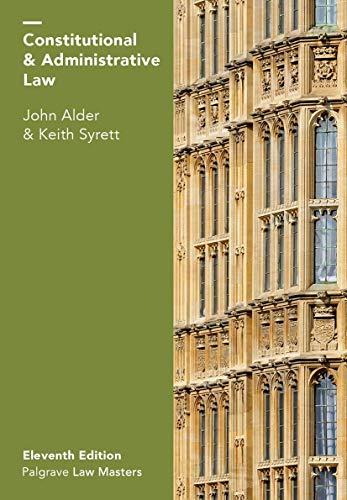Question
Canada is quite unique in the sense that we not only have laws which are designed to protect our rights and freedoms, we also have
Canada is quite unique in the sense that we not only have laws which are designed to protect our rights and freedoms, we also have The Charter of Rights and Freedoms which is a part of our constitution. The Constitution is a set of laws containing the basic rules about how our country operates. For example, it contains the powers of the federal government and those of the provincial governments in Canada as we discovered in Unit One. The Charter sets out those rights and freedoms that Canadians believe are necessary in a free and democratic society.
A Brief History of the Charter
The History of the Charter can be broken down into four major focus points.
1. Prior to the Bill of Rights
As a former colony of the British Empire, Canada inherited the principle of legislative supremacy from the United Kingdom. This is explicit in the British North America Act, which states that Canada would have a constitution "similar in principle to that of the United Kingdom."
The principle of legislative supremacy asserts that the legislative branch of government (i.e. the House of Commons and provincial legislatures) is the highest legal and political body of the land. There are no higher laws than those enacted by the legislature. Human and civil rights were the jurisdiction of the legislatures and the Canadian courts were reluctant to interfere.
In addition, Canada's constitution was under the jurisdiction of the United Kingdom Parliament. Canada could not change its constitution at home, but had to apply to the U.K legislature for any amendments.
2. The Bill of Rights
In 1960, John Diefenbaker's government passed the Canadian Bill of Rights. The Bill of Rights was a small document (only one and a half pages) that guaranteed several fundamental freedoms, legal rights, and equality rights. The Bill of Rights also provided a notwithstanding clause that allowed governments to enact legislation beyond its review.
Unlike the current Charter, the Bill of Rights was not entrenched in the Canadian constitution, but was simply an enactment of Parliament. As an ordinary statute, it was uncertain how it would take precedence over legislative supremacy. The Canadian courts failed to give the Bill of Rights a broad and liberal interpretation, preferring instead to construe it narrowly to avoid the appearance of interfering with the legislature's supremacy.
3. Towards the Charter
In 1971, under Prime Minister Pierre Trudeau, the federal and provincial governments reached an agreement called the "Victoria Charter." This agreement called for a constitutional charter of rights and the patriation of the Canadian constitution from the United Kingdom. The agreement eventually failed due to objections by the provinces of Quebec and Alberta.
In 1980, Trudeau announced that the federal government would proceed unilaterally (without the consent of the provinces) to patriat the constitution and entrench a charter of rights. However, after several inconclusive court decisions on whether the federal government could legally proceed in such a manner, the federal government and the provinces resumed negotiations.
On November 4, 1981, the federal government and the provinces struck a compromise on patriation of the constitution (known as the Vancouver Consensus formula) and the entrenchment of a charter of rights. All provincial premiers agreed to the compromise except for Quebec Premier Rene Levesque, who advocated stronger French language rights in the Charter.
4. The Charter Becomes Law
With the provinces' consent (minus Quebec), the federal Parliament requested the United Kingdom Parliament to patriat the Canadian constitution. On April 17, 1982, the Queen signed the Canada Act, 1982. The legislation added the Constitution Act, 1982 to Canada's constitution and changed the name of the British North American Act to the Constitution Act, 1867. The Constitution Act, 1982 contained the Canadian Charter of Rights and Freedoms and the Vancouver Consensus formula for future constitutional amendments.
Quebec never officially consented to the new Canadian constitution and the Charter. However, both the Supreme Court of Canada and Quebec Court of Appeal ruled that Quebec's consent was not mandatory and that the new Charter and its amending formula applied in law to that province.
In summary, the Bill of Rights had its limitations. The Bill of Rights as a statute did not take precedence over any other statute. If another statute conflicted with the Bill of Rights, it was up to a judge to decide which law to enforce. Also, as a statute it could be amended by a majority vote in the House of Commons. However, without Prime Minister John Diefenbaker's introduction of the Bill of Rights, the foundations for the Charter of Rights and Freedoms would not be present.
"The Bill of Rights did not offer Canadians sufficient protection. When Pierre Elliott Trudeau became prime minister one of his many goals was to patriate the Constitution and to entrench the Canadian Charter of Rights and Freedoms. Entrenching the Charter of Rights and Freedoms was significant because it shifted power from the supremacy of Parliament and Legislatures toward supremacy of the Constitution. This factor concerned some politicians. Agreement on the terms of patriation was reached on one condition. That a clause (the Notwithstanding Clause found in activity three) be added that would allow the provinces some power to overrideor legislate around the Charter of Rights and Freedoms" (Blair).
Explain the importance of entrenching the Canadian Charter of Rights and Freedoms in the Constitution.
How do rights and freedoms benefit you? Provide five good responses to the question.
Step by Step Solution
There are 3 Steps involved in it
Step: 1

Get Instant Access to Expert-Tailored Solutions
See step-by-step solutions with expert insights and AI powered tools for academic success
Step: 2

Step: 3

Ace Your Homework with AI
Get the answers you need in no time with our AI-driven, step-by-step assistance
Get Started


